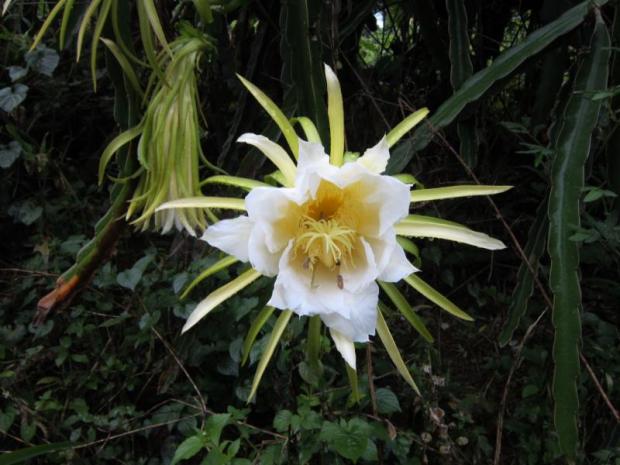Taking advantage of a four-day holiday recently, my family went upcountry to indulge in our favourite pastime: gardening. Leaving Bangkok at 1pm on Saturday, we arrived at our country home at 10pm and even before we reached the doorstep I had found the answer to a reader's question.

NOT JUST A PRETTY FACE: Dragon fruit is rich in minerals and vitamins, as well as antioxidants.
The reader had planted Hylocereus undatus, commonly known as dragon fruit, or kaew mangkorn in Thai, along his fence and they had begun to bloom, but the flowers never turned into fruit so he wanted to know why. I answered that I had never planted dragon fruit but I heard the flowers opened at night, and the lack of fruit could be due to the absence of pollinating bats and night-roaming insects like moths.
Before we could reach our country home we had to pass by a neighbour's lychee plantation. Arriving at night, the sight of countless dragon fruit flowers festooned along the fence of the plantation took my breath away. In full bloom, the cream-coloured flowers seemed to glow in the moonlight. So I was right that the flowers opened at night.
Bats and moths are likely pollinators, but of one thing I am sure: dragon fruit flowers are also pollinated by bees. The flowers on our neighbour's fence were open until before sunrise, and I observed bees merrily flying from one flower to another. As they entered a flower to suck its nectar, pollen became stuck on their feet and body; they then transferred these to the next flower that they entered, pollinating it in the process. Then, as the sun rose, the flowers closed, never to open again. As the flowers withered, the base of those that were successfully pollinated started to swell. In six to seven weeks, the fruits will be ready to harvest.
Mildly sweet and best served cold, the dragon fruit is usually eaten fresh as well as used in fruit salads. Researchers found it to be low in calories and high in fibre, with seeds containing polyunsaturated fatty acids — thus it lowers cholesterol and high blood pressure, and prevents constipation. The fruit has also been found to be rich in minerals, especially calcium and phosphorus, and vitamins B and C, as well as antioxidants, which help prevent the formation of carcinogenic free-radicals in the body.
Although the seeds germinate easily, the dragon fruit is best propagated from cuttings. If you have been given cuttings, leave them in a dry, cool place until the wounds have healed. Plant the cuttings individually in black plastic bags containing coarse sand mixed with coconut coir. Make sure the bags have holes at the bottom for drainage, and keep the soil moist but not soggy. After the roots have formed, in about six to eight weeks, the plants are ready to be transplanted.
The dragon fruit is a member of the Cactaceae family of plants and, like all cacti, it needs full sun. It does not like soggy soil, so plant it in sandy loam, which offers good drainage. Commercial growers raise the soil into a mound for better drainage, especially in the rainy season.
As this cactus is a vine, it needs support on which to climb. Our neighbour initially used his fence posts, but over the years the vines have covered the fence. Plantations I have visited use two-metre-high hollow concrete posts; with a string, four plantlets are tied around posts spaced three metres apart. As the plants grow, roots sprout on the stems and anchor them to the post. Attached to the top of the pole is a small horizontal trellis made of hardwood; after the vines have reached the top of the pole, they gather on the trellis, from where their fruit-bearing stems hang.
Dragon fruit vines propagated from cuttings usually begin flowering when they are about two years old. The flowers, which are fragrant, open at dusk and, as I have observed, close before sunrise. Some growers believe the flowers are self-pollinated, but I am sure the reason they have fragrance is to attract pollinators. Given enough fertiliser (NPK 15-15-15) diluted in water and applied every two weeks, and grown in suitable conditions (well-drained soil and full sun), two-year-old vines can yield up to 50 fruits ranging in size from 200 to 500g (or two to three fruits per kilo) per post per year, and up to 100 as they grow older.
The plants have few insect pests, but watch out for red ants, which nibble on the young stems, and they are susceptible to soil-borne fungi, which can be prevented by good drainage.
Email nthongtham@gmail.com.

FENCE SITTER: As dragon fruit is a vine, it needs support on which to climb.

REACHING OUT: Initially planted to climb a fence post, vines cover the whole fence.

CIRCLE OF LIFE: A dragon fruit flower being pollinated by bees.

